- Afrikaans
- Albanian
- Amharic
- Arabic
- Armenian
- Azerbaijani
- Basque
- Belarusian
- Bengali
- Bosnian
- Bulgarian
- Catalan
- Cebuano
- China
- China (Taiwan)
- Corsican
- Croatian
- Czech
- Danish
- Dutch
- English
- Esperanto
- Estonian
- Finnish
- French
- Frisian
- Galician
- Georgian
- German
- Greek
- Gujarati
- Haitian Creole
- hausa
- hawaiian
- Hebrew
- Hindi
- Miao
- Hungarian
- Icelandic
- igbo
- Indonesian
- irish
- Italian
- Japanese
- Javanese
- Kannada
- kazakh
- Khmer
- Rwandese
- Korean
- Kurdish
- Kyrgyz
- Lao
- Latin
- Latvian
- Lithuanian
- Luxembourgish
- Macedonian
- Malgashi
- Malay
- Malayalam
- Maltese
- Maori
- Marathi
- Mongolian
- Myanmar
- Nepali
- Norwegian
- Norwegian
- Occitan
- Pashto
- Persian
- Polish
- Portuguese
- Punjabi
- Romanian
- Russian
- Samoan
- Scottish Gaelic
- Serbian
- Sesotho
- Shona
- Sindhi
- Sinhala
- Slovak
- Slovenian
- Somali
- Spanish
- Sundanese
- Swahili
- Swedish
- Tagalog
- Tajik
- Tamil
- Tatar
- Telugu
- Thai
- Turkish
- Turkmen
- Ukrainian
- Urdu
- Uighur
- Uzbek
- Vietnamese
- Welsh
- Bantu
- Yiddish
- Yoruba
- Zulu
Aug . 01, 2024 03:11 Back to list
Top Manufacturers of Cast Iron Pipe Fittings for Reliable and Durable Plumbing Solutions
The Landscape of Cast Iron Pipe Fittings Manufacturers
Cast iron pipe fittings play a crucial role in various plumbing and construction projects, offering durability and reliability for transporting fluids. The manufacturing of these fittings is an essential part of the industrial ecosystem, driven by advancements in technology and increasing demand across numerous sectors.
Understanding Cast Iron Pipe Fittings
Cast iron pipe fittings are crafted from molten iron that is poured into molds and allowed to cool. The process results in a robust and corrosion-resistant product, essential for applications that require long-lasting infrastructure. These fittings are commonly used in water supply systems, drainage systems, and agricultural applications, where strength and stability are paramount.
Market Dynamics
The global market for cast iron pipe fittings is witnessing significant growth, spurred by urbanization, industrial development, and infrastructure projects. As cities expand and the need for reliable water management systems grows, the demand for high-quality cast iron fittings is on the rise. Manufacturers are continually innovating to meet these needs, ensuring their products are robust, cost-effective, and environmentally friendly.
Manufacturing Processes
The production process of cast iron pipe fittings entails several steps, including melting, casting, and machining
.1. Melting This stage involves heating scrap iron and adding alloying elements like carbon to achieve the desired chemical composition. 2. Casting The molten iron is poured into molds designed for specific fittings, such as elbows, tees, and flanges. The cooling process forms the cast iron into the required shapes. 3. Machining After cooling, the fittings undergo machining to achieve exact dimensions, surface finish, and threading needed for interconnection.
cast iron pipe fittings manufacturers

These steps require sophisticated technology and skilled labor, making it imperative for manufacturers to invest in both modern equipment and workforce training.
Leading Manufacturers in the Industry
Numerous companies stand out in the cast iron pipe fittings manufacturing sector. These manufacturers utilize state-of-the-art technology and adhere to stringent quality controls to produce fittings that conform to international standards. Renowned names in the industry often export their products globally, contributing to their reputation and market share.
These manufacturers focus not only on production efficiency but also on sustainability. Eco-friendly practices, such as recycling scrap metal and reducing waste during the manufacturing process, are becoming increasingly important as environmental concerns rise.
Challenges Faced by Manufacturers
Despite the booming market, cast iron pipe fittings manufacturers face several challenges. Fluctuating raw material prices can impact production costs, whereas stringent regulations regarding emissions and waste disposal necessitate compliance investments. Additionally, the competition from alternative materials, such as PVC and HDPE, continues to grow, pushing manufacturers to innovate and improve their products continuously.
Future Trends
The future of cast iron pipe fittings looks promising, driven by technological advancements and sustainable practices. Manufacturers are exploring new methods, such as 3D printing, which could revolutionize production efficiency and reduce lead times. Furthermore, the integration of smart technologies in plumbing systems suggests that the future may involve more than just traditional fittings.
In conclusion, cast iron pipe fittings manufacturers are vital to the infrastructure that supports modern society. As the industry evolves, manufacturers must adapt to changing market conditions, technological advancements, and environmental demands. The ongoing growth in urban development and the emphasis on sustainability will likely contribute to a robust future for cast iron fittings in various applications.
-
8mm Thin-Walled Cast Steel Manhole Cover Pallet Bottom Ring | Durable
NewsAug.04,2025
-
Premium Cast Iron Water Main Pipe: Durable, Corrosion-Resistant
NewsAug.03,2025
-
Durable Cast Iron Water Mains | AI-Optimized Systems
NewsAug.02,2025
-
High-Efficiency Propane Boiler for Baseboard Heat | Save Energy
NewsAug.01,2025
-
Premium Source Suppliers for Various Gray Iron Castings
NewsJul.31,2025
-
Durable Cast Iron Water Main Pipes | Long-Lasting
NewsJul.31,2025


